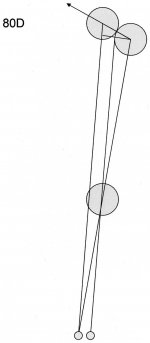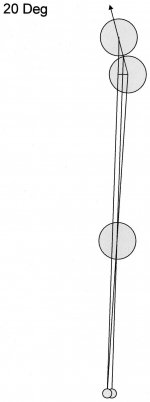Shot "A" is about a 10-degree cut, shot "B" is about a 15-degree cut, and shot "C" is about a 20-degree cut. All three shots fit into the "thick hit" category of CTE (see my
CTE page and
Spidey's blog for more info). Also, the CB-to-OB distance is the same for all three shots, so the "shot arc" is the exact same for all three shots (see my
CTE page and
Spidey's blog for more info).
Here is the
CTE aiming procedure for a "thick hit" shot, as I understand it:
1.)
ALIGN: (for thick cuts): Start with your cue parallel to the CB-center-to-outside-OB-edge line (CTEL) with the tip pointing at the outside edge of the CB (per the 2nd CTE version on my
CTE page).
2.)
PIVOT: Then pivot your tip toward the pocket until it reaches the CB's center. The "effective pivot length" or "pivot arc radius" you use during the pivot should be the distance from the bridge to the OB (see
Spidey's blog for more info).
Since all three shots are "thick hits," and since the CB-to-OB distance is the same for each, the "effective pivot length" or "pivot arc" is also the same for each (assuming the bridge length is the same for all three shots).
Here's the question I want people to answer with the experiment:
What do you do differently with the alignment and/or pivot steps of CTE to pocket each of these three shots?
I believe Stan said what I've been saying since the beginning of the CTE Aiming thread. You asked a similar question about 3 other shots and I said "alignment is what changes" AKA identifying the outermost edge.
So when you pocket these three shots, it sounds like your initial alignment is slightly different on each. Recently, you claimed the pocket location or the exact amount of cut needed for a shot doesn't affect the alignment or pivot. How can that be? The two balls have identical relationships for all three shots. The only thing different is the amount of cut you need.
Identifying the outermost edge isn't feel based - it's not an educated guess, per se. It's addressing the first possible edge of the CB that is in line with the CTEL.
But the CTEL and "first possible edge of the CB" is the same for all three shots, unless you consciously or subconsciously change your visual alignment to somehow adjust for the amount of cut needed.
I posted two pictures in the CTE Aiming thread that shows how edges shift based on perspective.
Sorry, but I didn't grasp the point of those rotated images. I'm not being mean, just honest.
The moment your eyes move, the edge you address on the CB changes and the edge you're sighting on the OB changes.
I guess the key is knowing how much to move the eyes for the three different shots. How do you judge this without taking the pocket location or amount of cut into consideration, or is this just done subconsciously.
I can show someone how to make them in a minute or two, consistently.
That is a
bold statement! I'll have to take your word for this. Will the "someone" also be able to make the same three shots if the balls were shifted a little (i.e., if the cut angles were slightly different), using what you showed them with the three original shots? Do you realize what you are claiming here? You are claiming you can show "someone" how to make any 0-to-30-degree cut-angle shot from any place on the table. Furthermore, that "someone" will pocket the balls "consistently" (i.e., they won't miss any of the shots very often). Furthermore, this can all be done in one or two minutes, with no practice time required beyond the 1-2 minutes. I guess you are also assuming the "someone" can't currently do this (pocket all of these balls consistently) with their current "system." If you can truly accomplish this, then you will become an incredibly wealthy man, and I will be the first to document your feat in the pages of Billiards Digest. You have my promise on that.
The diagrams you post do not show perspective at all: The CTEL you diagram likely isn't the line you see at the table
My diagram (see above) only shows the shot layout and the necessary CB and OB lines for the three shots. To pocket the balls, these lines must be as shown, regardless of any 3D perspective.
in order to see it, your eyes must be at an exact perspective (sighting straight down it, which no one does).
The moment your eyes move a hair, the CB edge you address changes and the OB edge sighted changes as well.
This sounds like the key for your version of CTE. You need to shift the eyes just the right amount to give the correct initial alignment required to create the necessary amount of cut after the pivot.
Obviously, one must pivot along a particular arc to make the shot. I could argue that it's not feel (for me) but it might be for someone else. I don't know, honestly.
... but based on your blog, the pivot arc should be the same for each of the three shots since the distance between the balls is the same, but maybe the subconscious also helps adjust the pivot arc the subtle, but necessary, amounts.
Thank you for contributing to the thread. I hope you don't think my replies are disrespectful ... that is not my intent. I'm just trying to help provide better understanding (for me and others).
Regards,
Dave


